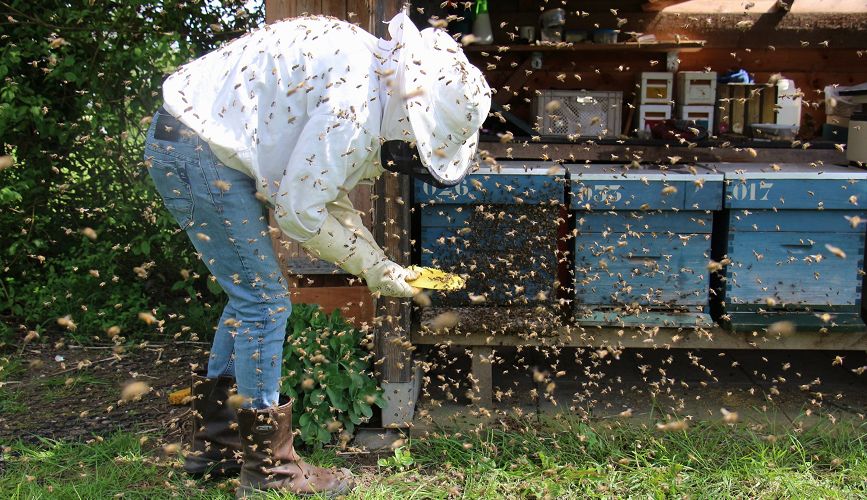Everything You Need To Know About Beekeeping Safety
There’s no way around it – caring for bees involves risk. Aside from the obvious danger of bee stings, there are other health and safety factors to consider. And as a beekeeper, it’s your job to be aware of these risks and know how to prevent and manage them.
From equipment to keep on hand to knowing your legal responsibilities as a beekeeper, we’ve outlined everything you need to know about keeping your bees, and yourself, safe.
Biggest safety risks around bees
Bee stings
Every beekeeper has a sting or two in their time – they’re painful, but individual stings are pretty manageable. Risks arise when you – or another person – have an allergic reaction to a sting. Even if you believe you’re not allergic, reactions can worsen the more you’re exposed to stings, so you can’t afford to be complacent.
Aside from your own safety, you need to think of others who might be around your bees – visitors, family members or neighbours. If you know the signs of a severe reaction and what to do if it happens, you’re less likely to panic if someone does get stung.
Normal reaction
- Instant, sharp burning pain around the sting
- Slight swelling around the sting
- A red welt at the sting site
In a mild reaction, these symptoms should disappear within a few hours and can be treated with home remedies such as honey or apple cider vinegar on the sting site.
Moderate reaction
- Extreme redness around the sting area
- Swelling around the sting site – this may enlarge over the following days
This type of reaction may require antihistamines and a visit to your GP if symptoms continue.
Severe reaction
- Skin reactions such as hives or itching
- Pale, flushed skin
- Swelling of the throat and tongue
- Difficulty breathing
- Swelling over a large part of the body
- Weak, rapid pulse
- Nausea or diarrhoea
- Dizziness
- Stomach cramps
- Loss of consciousness
If you or someone around your hives develops these symptoms, you must call an ambulance immediately.
Getting burnt
If you’re ill-prepared, burns can be common in your day-to-day as a beekeeper. There are two main hazards to consider and both are easily preventable:
Using a smoker – if you use a smoker to calm your bees, you need to use it correctly or you run the risk of burning yourself.
American Foul Brood infestation – a hive detected with AFB must be burnt within seven days of finding it. If you find yourself in this situation, refer to these guidelines to ensure you do it safely.
Injury
Walking to beehives in wet conditions, lifting heavy hive boxes, using hive tools to pry frames apart, constructing hive parts – there are several ways to injure yourself in the course of your beekeeping. As with any activity, it’s about being prepared and careful. Wear appropriate footwear, get help if you struggle to lift heavy hives and use quality tools to minimise the risk of injury.
Biosecurity hazards
A huge part of beekeeping safety is understanding common bee pests and diseases, as well as your legal obligations around them. It’s your responsibility to be aware of any signs of infestation and to report anything suspicious to your local biosecurity management immediately.
Take a look at our pest and disease articles for more information.
Top tips for responsible beekeeping
You can’t prevent every injury or sting, but you can be prepared for adverse outcomes. Here’s how to minimise the risks for you, your neighbours and your bees.
Have first aid gear on hand
As a beekeeper, you should always have an EpiPen, antihistamines and a fully-equipped first aid kit on your property. That way, if someone does get injured or has a bad reaction to a sting, you can manage the situation.
Know your stuff
This is beekeeping 101, but if you’re prepared and confident, your chance of risk is significantly reduced. If you or someone else does get stung, you’ll know how to handle the situation calmly and confidently.
Inform neighbours that you have bees on your property
It’s a courteous gesture to make others aware that you have bees on your property. If someone lives close to your home and is allergic to bees, you could save them an allergic reaction if they know to stay clear of your hives.
Choose a location suitable for your hives
Similarly, you need to consider your surroundings when choosing where to place your hives. Somewhere close to a public road or shared driveway is not the most thoughtful option – choose somewhere you know your bees will be protected, and others will be protected from them.
Maintain best beekeeping hygiene
Keeping your hives vibrant and healthy is important for many reasons, like protecting your bees from diseases and steering pests away. Wash beekeeping equipment regularly and don’t share equipment or honeycomb, to decrease the risk of infection, diseases and pests in your hive.
Wear appropriate protective clothing and equipment
You should never tend your bees without full protective gear. Even if you’ve been in the business for years, it’s still important to be prepared and protect yourself from possible stings. Reactions to stings can get worse over time, and bee behaviour can be unpredictable.
Be cautious when moving bees
Bees don’t like vibration. If they are knocked accidentally, they may perceive it as an attack on the colony which could cause them to sting. Be extra careful when moving them to ensure they don’t become agitated.
Be mindful of your bees’ space
Again, you want to avoid your bees feeling threatened at all costs. When you approach the hive, do so from the rear or the sides – this is much less invasive and your bees won’t feel as though they’re being attacked.
Use a smoker
Some beekeepers may be reluctant to use a smoker, but it’s a valuable tool. As a natural way to calm your bees, a smoker can prevent stings and make working on your hives easier.
Health and safety guidelines for beekeepers
New Zealand
There is legislation in place to support beekeepers and protect the honey industry, including the Biosecurity Act 1993, Biosecurity (National American Foulbrood Pest Management Plan) Order 1998, and the Biosecurity (American Foulbrood – Apiary and Beekeeper Levy) Order 2003.
NZ also has a voluntary beekeeping Code of Conduct, created by Apiculture New Zealand – a voluntary membership organisation that represents more than 2000 beekeepers. It aims to support, advocate for and deliver benefits to the apiculture industry for backyard beekeepers, commercial beekeepers and honey exporters. Apiculture also offers resources and information on its website to assist with health and safety in New Zealand beekeeping.
Australia
The Biosecurity Code of Practice is a framework outlining requirements for Australian beekeepers, to help maintain biosecurity and minimise the risk of pests and diseases damaging the industry. The framework is endorsed by every state and territory in Australia, but each state has its own legislation.
- Australian Capital Territory – Animal Diseases (Beekeeping) Amendment Act 2015
- New South Wales – Biosecurity Act 2015
- Queensland – Biosecurity Act 2014
- Victoria – Livestock Disease Control Act 1994
- South Australia – Livestock Act 1997
- Tasmania – Animal Health Act 1995
- Western Australia – Biosecurity and Agriculture Management Act 2007
- Northern Territory – Livestock Act 2009
Know the risks, bee prepared
As always, your greatest path to safe beekeeping is knowledge. The more you know, the more you can prepare and the safer your situation will be.
Want to learn more? Check out some of our other blogshere.

